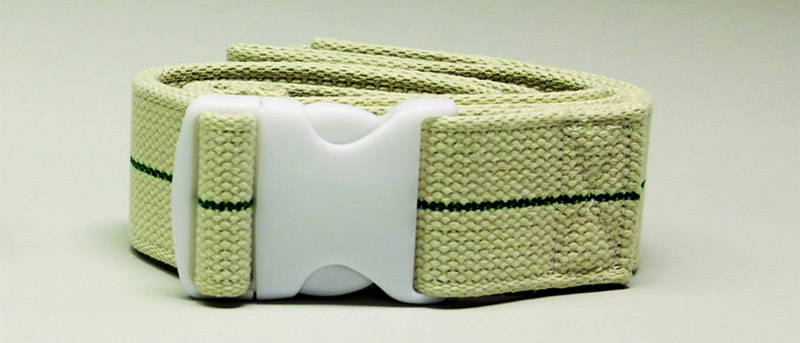Author: Wendy Wintersgill, MSN, RN, CRRN, ONC, ACNS-BC, and Gary A. Greenslade, MPT
An organizational road map to gait belt use.
Safe patient handling training for nurses, physical therapists, occupational therapists, and nurse aides should include the use of transfer aids, lifts, and gait belts. (See Mobility and lift safety tips.) Gait belts, the focus of this article, can help enable functional mobility and reduce patient falls and patient and staff injuries. Without gait belt use, an organization has a gap in its safe patient handling and mobility programs. (See Fall prevention and organizational health.)
To change practice in your organization and improve safety with gait belts, make a plan, choose the gait belts that are right for your organization and patient population, build an education team, develop a sustainability strategy, and reward compliance.
[su_note note_color=”#F2EBDD” text_color=”#2f2f2f”]
Mobility safety tips
Because gait belts allow patients to participate in transfers, which is beneficial to early mobility and rehabilitation, more healthcare workers—nurses, physical and occupational therapists, and nurse aides—are learning how to use them. Keep these gait belt and general safety tips in mind.
- Use gait belts to safely steady patients; never use them to lift patients.
- Boost patients from their bottom to help them complete a transfer and ambulate safely with proper assistance (1- or 2-person), contact guard to moderate assis-tance and using a walker or appropriate assistive device.
- Never use more than two people to assist a patient. More than two helpers can increase risk of patient and staff injury.
- If the patient requires two helpers, each providing more than minimal assistance, consider a partial standing lift or a total sling suspension lift.
[/su_note]
[su_note note_color=”#F2EBDD” text_color=”#2f2f2f”]
Fall prevention and organizational health
Fall prevention efforts should always focus on patient and staff safety. But an organization’s financial health and reputation also should be kept it mind as they can be damaged when falls occur
- After a fall, the organization is responsible for the patient’s care and follow-up (X-rays, computed tomography scans, increased nurse surveillance, and longer hospital stays), which, according to The Joint Commission, can cost up to $14,000.
- If goals for falls prevention aren’t met, an organization might see reductions in overall payments from the Centers for Medicare and Medicaid Services (CMS).
- Poor outcomes lower organizations’ scores on the CMS hospital compare website and among consumer advocacy groups where consumers may shop for the best performing hospitals.
- High fall rates, falls that result in injury, and high nurse injury rates can jeopardize Magnet® designation.
[/su_note]
Change organizational practice
Start by educating nurses on mobility assessment (see the article on page 32) and set the expectation for gait belt use with policy revisions, standard work (step-by-step guide that reduces the chance of variation), and a competency skills behavior checklist. These tools make expectations clear and establish that a gait belt must be used to mobilize any patient or resident who isn’t independently mobile.
Standardizing work to reduce variation has been a golden rule in healthcare improvement for years. It sounds simple, but the Advisory Board research company recently reported that two out of every three healthcare change initiatives fail. To increase the chance for success, engage staff in the planning and implementation process.
Plan for change
Plan your change with your organization’s calendar in mind, and involve nurse managers in this decision; they’ll know where to balance initiatives around other resource intensive calendar activities, such as new employee onboarding, competency skill days, and meetings.
More important than the launch date are the people who will be involved. All stakeholders (the people who will help to establish the plan and make it work) must be engaged from the outset. Stakeholders will vary depending on the organization and its culture, but a good start should include the full spectrum of nurses (managers, direct care, clinical nurse specialists, clinical educators, professional development specialists, nurse aides, and patient care assistants); physical and occupational therapists; transport teams; infection preventionists; purchasing staff; environmental services, housekeeping, and maintenance staff; and patients.
Choose your product
A wide range of gait belts is avail-able. Some belts are single-use and others can be cleaned and used with multiple patients. Many acute care and post-acute care settings provide a single cotton web belt for each patient, labeling it with the patient’s name to prevent mix-ups. If a sturdy, cost-effective wipeable belt is part of the patient environment of care, partner with environmental services or housekeeping team members to wipe belts clean when a patient is discharged so that it’s ready for the next patient. Use a permanent marker to label the belt with the assigned room number and location (for example, bed A, bed B, D [door], or W [window]).
Some acute care hospitals prefer wipeable belts in all areas except in orthopedic and joint replacement units, where a single-use belt makes sense. In these units, therapists can instruct family and other caregivers how to safely continue to use the gait belt at home.
Many companies manufacture gait belts in a variety of colors, pat-terns, sizes, buckle types, grab loop options, and prices. Begin your selection with a product review event to include all disciplines that will use the belts (nurses, physical and occupational therapists, aides, and techs) as well as all purchasing stakeholders (infection preventionists and members of your value analysis or new products commit-tee). If your organization has a patient advisory or community consumer group, invite them to provide a patient perspective, which can be used to craft the right messaging for patient education, brochures, and videos. Make the product review a fun event by welcoming participants and offering beverages with a light snack. Provide a simple paper or electronic survey so that everyone can vote for the belt he or she likes best. Be transparent and share the survey results with all stakeholders before making a final decision.
As part of your planning, discuss where gait belts will be located. To ensure consistent use, they should be placed at the point of care, next to every patient bed. Belts for larger patients can be kept in the clean utility room and exchanged for standard-length belts when needed. (See Gait belt placement.)
[su_note note_color=”#F2EBDD” text_color=”#2f2f2f”]

Gait Belt Placement
Gait belts should be placed next to every patient bed to reinforce their use. However, many rooms have limited space and walls already are covered with medical and patient care equipment. In addition, the layout of the rooms may vary. Enlist nurses to tour all of the patient rooms to identify the best location in each. They can place a sticky note at each location, which can then be critiqued by other nurses and staff. When the final locations are chosen, place a maintenance request to have hooks in-stalled where the gait belts will hang.
[/su_note]
Identify your education team
Work with clinical nurse specialists, the staff professional development team, or clinical educators to revise your organization’s falls prevention policy, develop standard work, and create a competency behavioral skills checklist for staff education. Depending on organizational culture and previous gait belt experience, you may want to include a physical therapy team member. The education team can provide training and complete competencies for unit-based rising star champions and staff from ancillary departments, such as transport, imaging, and the catheterization lab, who will need to know how to use gait belts. These education team members can lead peer-to-peer gait belt competency checks for implementation.
Sustain use
Begin to reinforce gait belt use with staff observation. For example, if you see a staff member walking a patient without a gait belt, ask, “Is your patient independent?” Those using light-touch or hands-on will get the message because their patient can’t ambulate independently. If a gait belt is needed, help walk the patient safely back to his or her room or get a chair for the patient until a gait belt can be retrieved and securely placed. Being present and using this just-in-time education for the first 2 to 3 weeks of implementation establishes the expectation that gait belts will be used. As compliance rounding becomes regular, so does gait belt use. Measures of success are reduced falls, reduced severity of patient injuries when falls do occur, and fewer staff injuries. Unfortunately, the value of gait belt use is felt most when someone does-n’t use a gait belt and a patient falls.
Reward compliance
Recognize staff who use gait belts as expected. Thank them for being a gait belt champion and cheer them for their contribution to patient safety. Some organizations use electronic kudos (an electronic gift card or a simple email) and others may use handwritten notes. Pizza celebrations also work well. Use whatever reinforcement you can to reward gait belt users for following through.
Share your success
Although we can’t scientifically prove the efficacy of gait belts with randomized clinical trials, we can show how they improve safety and outcomes and are an important part of evidence-based practice (EBP).
Disseminating your story and its outcomes is the final step in EBP. Partner with someone to publish or present your experience (via a poster or podium presentation) or write an abstract for conferences. Show how your staff expertly implemented a culture of gait belt use and demonstrate that you’ve reduced patient and staff injury. Post-acute care organizations can present their stories at the annual Association of Rehabilitation Nurses REACH conference. If a nation-al conference isn’t feasible, consider a local or regional meeting.
Whatever the venue, share your success and publish your story. Each retrievable citation grows the body of evidence that gait belt programs are valuable to patients and an organization’s safety culture.
The authors work at Penn Medicine Lancaster General Health in Lancaster, Pennsylvania. Wendy Winters-gill is a clinical nurse specialist in the orthopedic service line at Penn Medicine Lancaster General Health and director of the Association of Rehabilitation Nurses in Lancaster. Gary A. Greenslade is a physical therapist.
The content in this Focus On does not necessarily rep-resent the views of the American Nurses Association.
Selected references
Joint Commission, The. Sentinel event alert 55: Preventing falls and fall-related injuries in health care facilities. September 28, 2015. jointcommission.org/assets/1/6/SEA_55_Falls_4_26_16.pdf
Miller H, Rockefeller K, Townsend P. Inter-national round table discussion: Do gait belts have a role in safe patient handling programs? Int J Safe Patient Handl Mobil. 2017;7(3):116-21.
Vonderhaar K. Research report: Drive organizational change—without overloading managers: Best practices for maximizing managers’ finite capacity. September 17, 2017.
Advisory Board HR Advancement Center. advisory.com/research/hr-advancement-center/studies/2017/drive-organizational-change-without-overloading-managers
